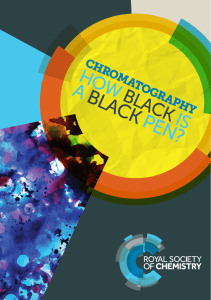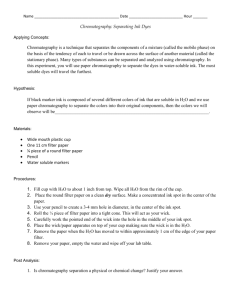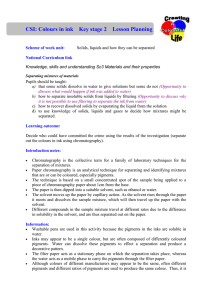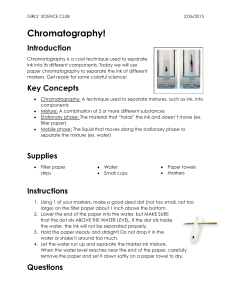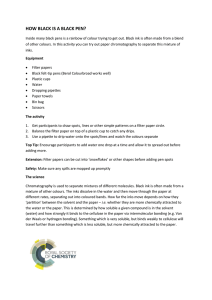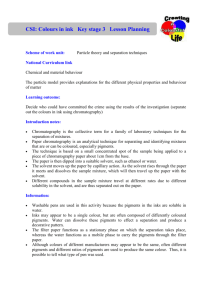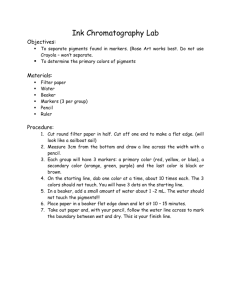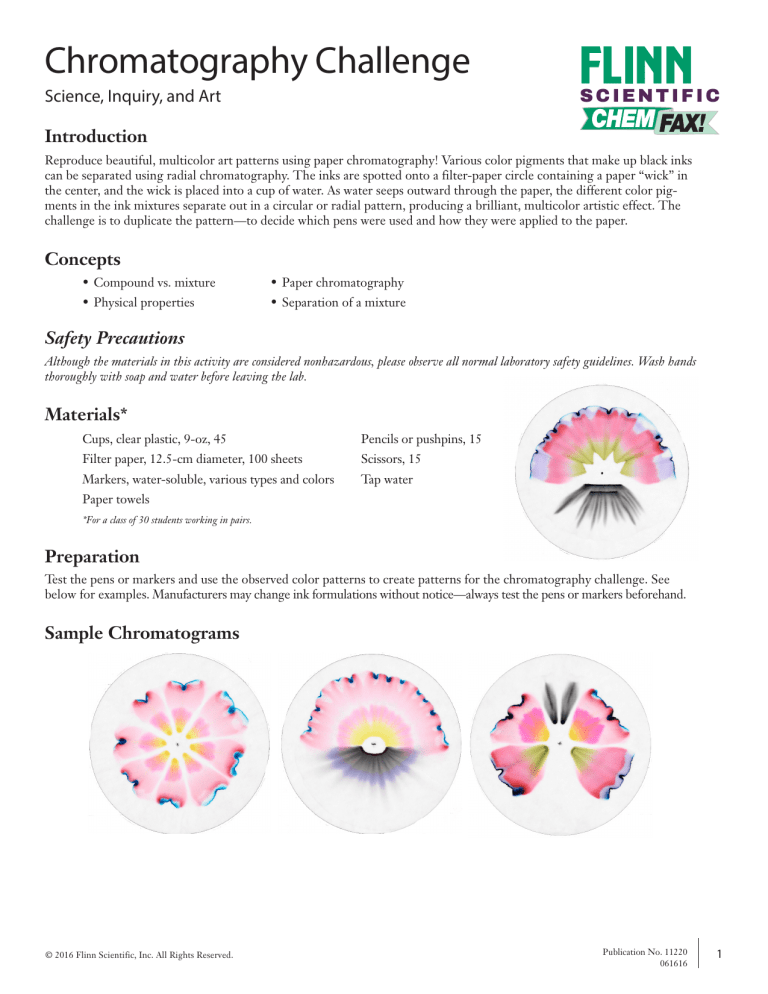
Chromatography Challenge SCIENTIFIC Science, Inquiry, and Art Introduction Reproduce beautiful, multicolor art patterns using paper chromatography! Various color pigments that make up black inks can be separated using radial chromatography. The inks are spotted onto a filter-paper circle containing a paper “wick” in the center, and the wick is placed into a cup of water. As water seeps outward through the paper, the different color pigments in the ink mixtures separate out in a circular or radial pattern, producing a brilliant, multicolor artistic effect. The challenge is to duplicate the pattern—to decide which pens were used and how they were applied to the paper. Concepts • Compound vs. mixture • Paper chromatography • Physical properties • Separation of a mixture Safety Precautions Although the materials in this activity are considered nonhazardous, please observe all normal laboratory safety guidelines. Wash hands thoroughly with soap and water before leaving the lab. Materials* Cups, clear plastic, 9-oz, 45 Pencils or pushpins, 15 Filter paper, 12.5-cm diameter, 100 sheets Scissors, 15 Markers, water-soluble, various types and colors Tap water Paper towels *For a class of 30 students working in pairs. Preparation Test the pens or markers and use the observed color patterns to create patterns for the chromatography challenge. See below for examples. Manufacturers may change ink formulations without notice—always test the pens or markers beforehand. Sample Chromatograms © 2016 Flinn Scientific, Inc. All Rights Reserved. Publication No. 11220 061616 1 Chromatography Challenge continued General Procedure 1. Obtain a piece of filter paper. Using a sharp pencil or a pushpin, poke a small hole in the center of the filter paper. 2. Fill a plastic cup to within about 1 cm from the top with tap water. 3. Starting at least 5 mm from the center hole, place a small but concentrated spot of ink from a water-soluble marker or pen onto the paper. The “spot” may be a dot, a wedge, a short line, an arc, etc. See Figure 1 for an example. 4. Cut a piece of filter paper into eight pie-shaped wedges (see Figure 1). Filter Paper Ink Dots Hole Ink Line ConeShaped Wick Plastic Cup Water Wedge-Shaped Paper 5. Roll up a filter paper wedge into a tight cone and insert the cone-shaped “wick” into the hole in the center of the filter paper. 6. Set the prepared filter paper circle on top of the water-filled cup. When the water has advanced to within 1–2 cm of the outer edge of the filter paper (about 10–12 minutes), carefully lift the chromatogram and set it on a paper towel to dry. 7. Repeat as many trials as needed to identify the color pigments in different markers and to discover the patterns produced by different types of “spots.” 8. Working with a partner, write and carry out an “action plan” to reproduce the art chromatogram created by the teacher. Discussion Chromatography is a general term describing a variety of analytical methods for the separation and identification of the compounds in a mixture. In paper chromatography, a mixture is “spotted” onto a special type of highly absorbent paper, and a solvent is then allowed to seep through the paper by capillary action. The compounds in the mixture become separated as they dissolve in the solvent and travel up the paper at different rates, depending on their relative affinity for the paper versus the solvent. Discussion Questions 1. Why is important that only the wick and not the filter paper circle be in contact with the water in the cup? 2. What are some of the variables that will affect the pattern of colors produced on the filter paper? 3. Why does each ink separate into different pigment bands? 4. Choose one color (e.g., yellow, red, or blue) that is present in more than one type of ink. Is the pigment (compound) that gives this color always the same? Do any of the pens appear to contain common pigments? Explain. 5. Why are only water-soluble markers or pens used in this activity? How could the experiment be modified to separate the pigments in “permanent” markers or pens? 2 © 2016 Flinn Scientific, Inc. All Rights Reserved. Chromatography Challenge continued NGSS Alignment This laboratory activity relates to the following Next Generation Science Standards (2013): Disciplinary Core Ideas: Middle School Science and Engineering Practices MS-PS1 Matter and Its Interactions PS1.A: Structure and Properties of Matter Disciplinary Core Ideas: High School HS-PS1 Matter and Its Interactions PS1.A: Structure and Properties of Matter HS-PS2 Motion and Stability: Forces and Interactions PS1.B: Types of Interactions Asking questions and defining problem Planning and carrying out investigations Constructing explanations and designing solutions Crosscutting Concepts Patterns Cause and effect Structure and function Tips • The activity may be completed in two 50-minute class periods. One period is usually needed to identify the pigments present in different inks and to determine the effects produced by different types of ink “spots.” The second class period may then be devoted to duplicating the art chromatogram produced by the teacher. Alternatively, the second part of the activity may be completed as a take-home assignment. • Experiment with a variety of water-soluble markers or felt tip pens to determine the ink composition. The pigments for pens we have tested are listed below from least mobile to most mobile. Colors in parentheses may be indistinct or blend in with other pigments. Expresso: Dark midnight blue, gray, dark gray. Prang: Pink, orange, yellow, blue. Vis-Aid: Yellow-green, blue, (lavender) purple. Mr. Sketch: Yellow, orange, rose, pink, blue. LePen: Brown (yellow), purple, turquoise. PaperMate: Gray (purple), yellow, blue, lavender. Vis-à-vis: Yellow, rose (red-orange), purple, turquoise • Number or code the markers in some way and place them in a central area for students to share. • Coffee filters may be substituted for the filter paper. The “ruffled” sides of the coffee filter should be removed with scissors. Water is more quickly absorbed by coffee filters than by filter paper. This will reduce the separation and resolution of the ink pigments. • If a chromatogram is running too slowly, check to make sure that the wick has been inserted snugly into the hole and that there is good contact between the wick and the inside edge of the hole. Typical running times for the chromatograms are 10–12 minutes. • Avoid excessive handling of the filter paper. Oils from the skin can interfere with capillary action that draws the water through the paper. Answers to Discussion Questions 1. The filter paper should not be in direct contact with the water in the cups—otherwise, the ink spots will just dissolve in the water. Water seeps through the paper by capillary action, carrying the ink pigments with it. 2. The color patterns produced by different inks will depend on the individual pigments in the ink, their chemical structures, and their physical properties, such as polarity and solubility. 3. Each ink is a mixture and has a different formulation composed of different chemical compounds. 4. In most cases, it appears that multiple pigments may be used to achieve the same color. There are some common pigments, however. The yellow (least mobile) pigment in several pens may be the same compound. There also appears to be a common lavender pigment in 3 © 2016 Flinn Scientific, Inc. All Rights Reserved. Chromatography Challenge continued several pens. 5. The ink must dissolve in the water in order to migrate with the water thorugh the paper. If the ink does not dissolve in water, the ink spot will remain at the origin. The experiment may be modified to separate the pigments in permanent markers by running the chromatograms with an alcohol solvent, such as isopropyl alcohol. References This activity was adapted from Flinn ChemTopic™ Labs, Vol. 2, Elements, Compounds, and Mixtures; Cesa, I., Editor; Flinn Scientific, Inc; Batavia, IL (2006). Special thanks to Bob Becker, Kirkwood High School, Kirkwood, MO for his original input regarding this idea. The Chromatography Challenge—Science, Inquiry, and Art is available as a Student Laboratory Kit from Flinn Scientific, Inc. Catalog No. AP7174 AP4503 AP5992 FB0586 AP6873 AP3104 Description Chromatography Challenge—Science, Inquiry, and Art Introduction to Paper Chromatography Kit Chromatography Centrifuge Kit Plant Pigment Chromatography Kit Black Markers, Assorted Set of Eight Filter Paper, Qualitative, 12.5 cm Consult your Flinn Scientific Catalog/Reference Manual for current prices. 4 © 2016 Flinn Scientific, Inc. All Rights Reserved.

